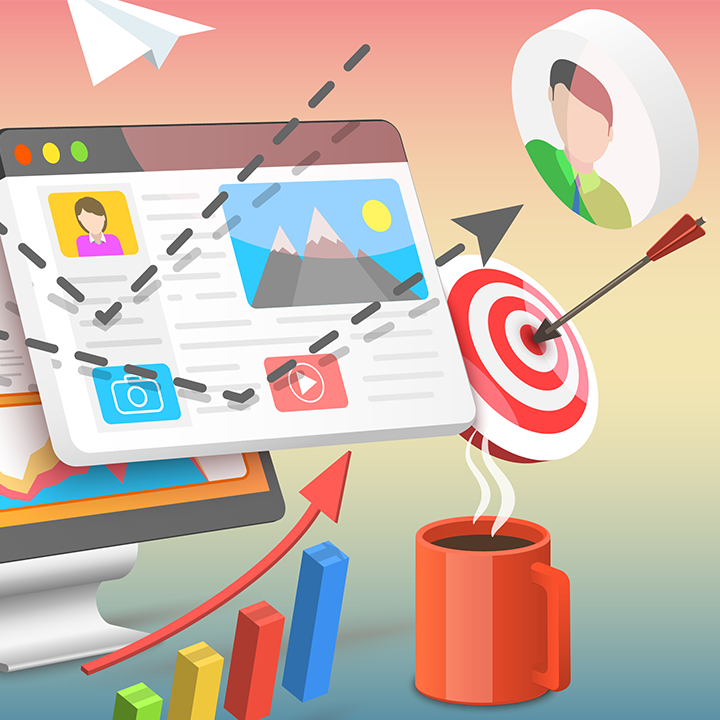If you have a website or a blog and you are wondering how to reduce the bounce rate?, you are in the right place because today we are going to show you how to measure it correctly, plus we will give you the best tips to reduce this rate.
With so many pages on the Internet fighting for the attention of users, it is best to always be aware of your statistics and willing to review and improve your mistakes so that in addition to attracting visitors you also get interaction and conversions. So if you want your visitors to stay longer on the web do not miss the following tips.
What does the bounce rate measure?
The bounce rate is one of the most important metrics in web analytics statistics, it basically measures the behavior of users on a web page. As you can imagine this data is one of the best tools we have to know how well our site is working and how much the public likes it.
In clearer words the bounce rate measures how many users enter your website and interact on it, either spending several minutes reading an article or browsing between the different tabs of the site. So, as you can imagine it is a great way to check if you are doing things right for your customers and if you are achieving your goals.
How to measure bounce rate?
Google Analytics is one of the most complete tools to measure not only bounce rate but other important metrics for our site. You can configure this tool in a few steps, in this blog you have a guide to start with the basic configuration.
If you are not interested in using this tool you can do this metric on your own using the following formula: number of users that enter without interacting divided by the total number of users. Ideally, this percentage should be between 20% and 50%. So if your percentage is higher than this it is time to review your website and read our tips to reduce it.
Tips to reduce bounce rate
Imagine you have a physical store in a shopping mall or on a busy avenue, you have made an effort to make it eye-catching, or at least you think so, because every time someone passes by your store they turn to look at it, but immediately turn around and leave or worse, potential customers come in and take a look, but they put a dismissive look and also leave. This is precisely what happens when you have a high bounce rate, luckily there are many things you can do to get that person who was interested to finally decide to enter.
1.- Evaluate if you are measuring the bounce rate properly
One of the best tools to measure the bounce rate is Google Analytics that can measure without so many complications how many users enter your site and how many interact on it, either by browsing different pages or leaving comments, however if you have a blog or a website designed under the “Unique Layout” model you have probably noticed that in Analytics your bounce rate is very high, maybe around 80%.
If this is your situation, don’t worry because it may be that this percentage is miscalculated. Blogs and “Unique Layout” pages, i.e. pages designed to show everything in a single view, have the disadvantage that they give very little opportunity for interaction with the visitor, and this is not bad because often the purpose of these pages is only to read an article.
So if your user is only entering to read your page or blog you are fulfilling one of your objectives, however for Google Analytics all these entries are recorded as bounces. What you need to do is to program Analytics to indicate that it should start measuring the time the user stays on a certain article or page. For example, if you have determined the reading time of a certain post to be 8 minutes, then you should ask the algorithm to calculate the scroll time on the page to be at least 6 minutes to count as interaction. This way you will have more accurate results on whether people are reading you or just enter and leave without reading.
2.- Design a better user experience
Sometimes we design our site according to what we think is convenient, but sometimes we forget that those who will use the site will be people outside of us and they are the ones who should like it, this is precisely the goal of UX Design or user experience design, on other occasions we have already mentioned how important it is to put users at the center of our company and our website does not have to be different.
If you have the budget you can hire a UX Design professional who will help you evaluate if your website has the necessary elements to please your visitors, and also evaluate the ease with which users can navigate and interact on your page.
If you don’t have the budget to hire a professional you can start by doing a survey among your acquaintances about the ease of use of your website. You can start by asking them to evaluate the following aspects:
- The site is easy to use
- It has what you are looking for within reach
- It inspires confidence
- The loading time is ideal or is it too slow?
According to the results of this first survey change aspects such as tab distribution, add data of interest or necessary elements such as live chat or FAQs, if it loads slowly delete some plugins that you do not need to optimize the load. Detecting small bugs, even with a small audience, can help you improve the user experience so that visitors stay longer.
3.- Use images and multimedia content
Human beings are much more visual, surely you are too. No matter how much you like to read, an image at first glance can get your attention better than a sentence or a short text. So it is important that you use images in your site. Also, it is an excellent idea that you decide to upload some videos about your products.
This recommendation is especially necessary if we are talking about landing pages, since their goal is to convert and capture leads, so this type of pages must be especially striking for users to fill out a form, make a purchase or sign up for a document.
4.- Avoid overloading your page
As we mentioned before images and videos are able to attract more attention than text, this is an excellent way to make your visitors stay a little longer, but be careful not to overdo it because too many images, pop ups or ads make the page look unreliable and consequently visitors may leave your page almost after entering.
Also too many pop ups, ads and banners make your page load slower and worsen the user experience.
5.- Use interactive content
One of the best strategies to make your visitors stay longer is to invite the user to interact, for this there are several strategies. One of them is to add links within our content to another part of our site, this way while the user reviews something on a topic can move to another related post and this in turn can lead to another entry, this is a particularly useful technique if you have a blog.
Also, you can add a test, quiz or survey that may be interesting to your customer, so he will spend more time on your page solving it, at the end you can direct him to other content on your website.
6.- Live content
The confinement by the pandemic accustomed more people to webinars or conferences online, so you can take advantage of this and add live content to your site, so people who are interested in your products will stay much longer, plus they can interact on your page by adding comments. So consider doing a live broadcast on some fundamental content on your website, presenting a product or to clarify doubts about your brand, because your customers will thank you, plus your bounce rate will be reduced drastically.
As you can see, identifying problems and needs of your buyer is one of the most important keys to create a website that makes them fall in love and have a good time on it. Tell us, do you know any other strategy that can help lower the bounce rate?

